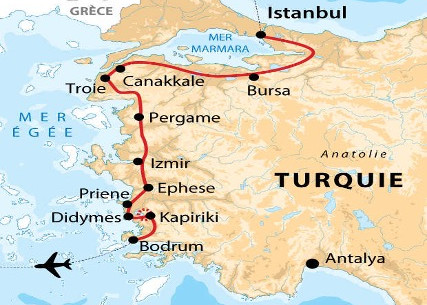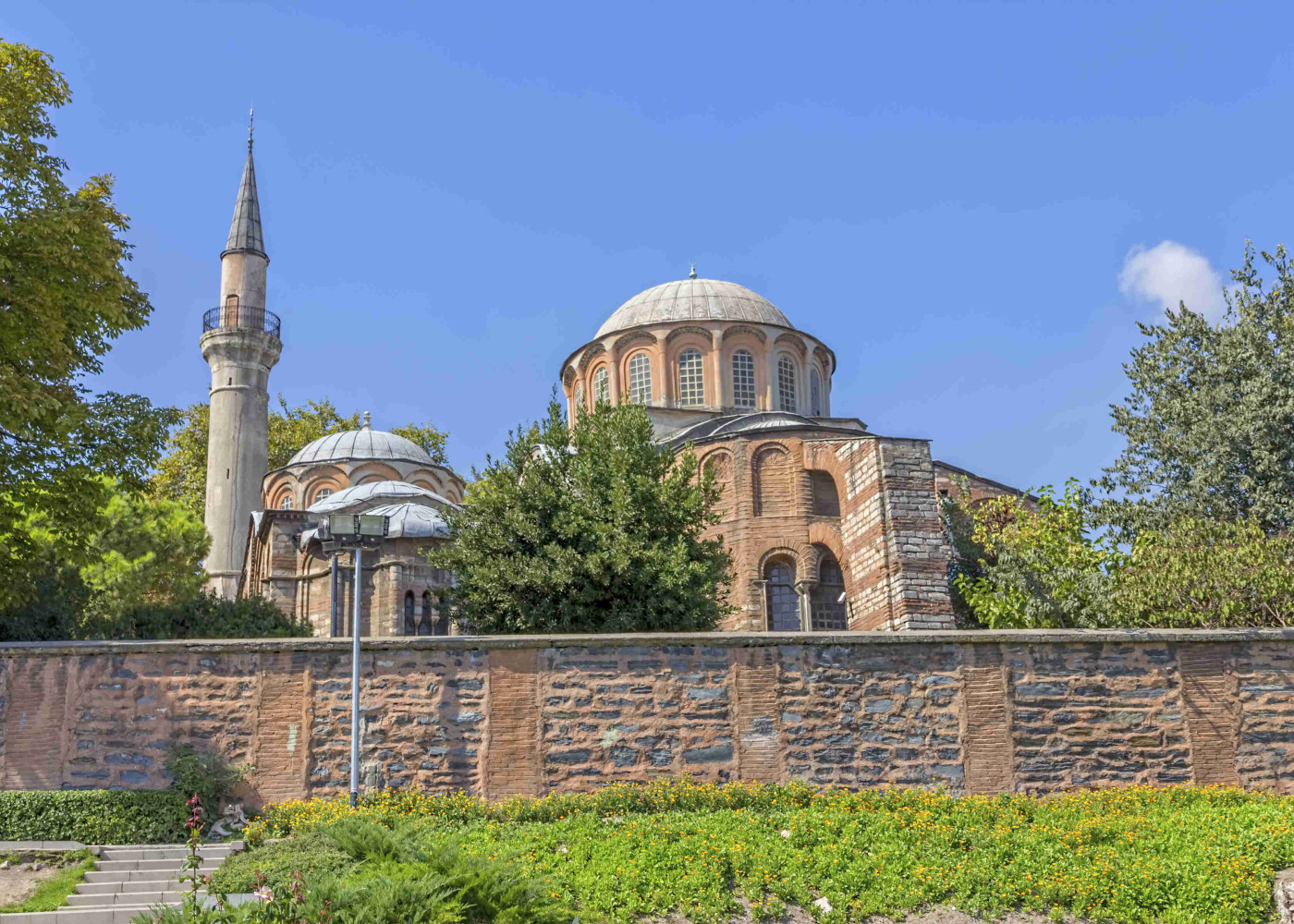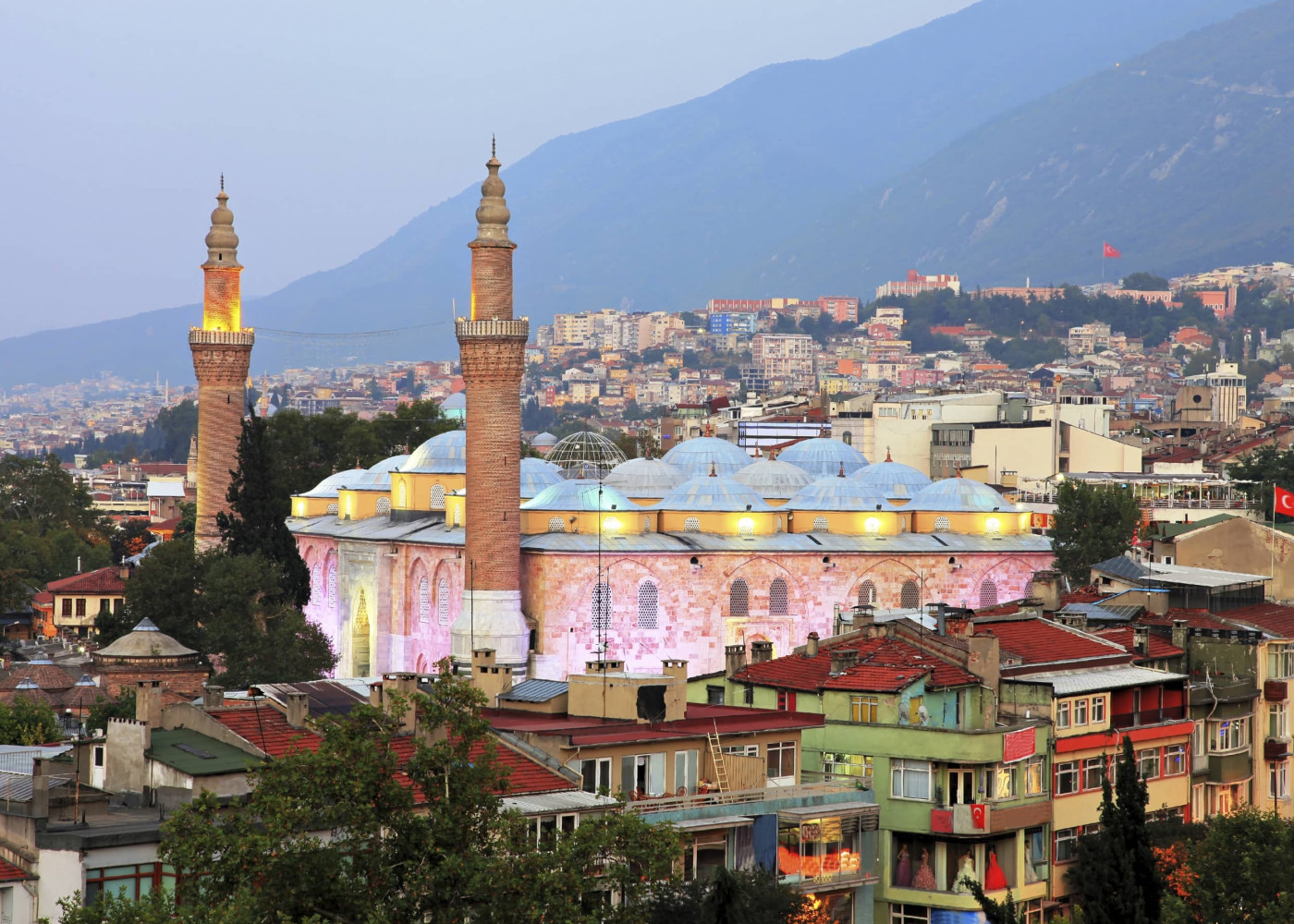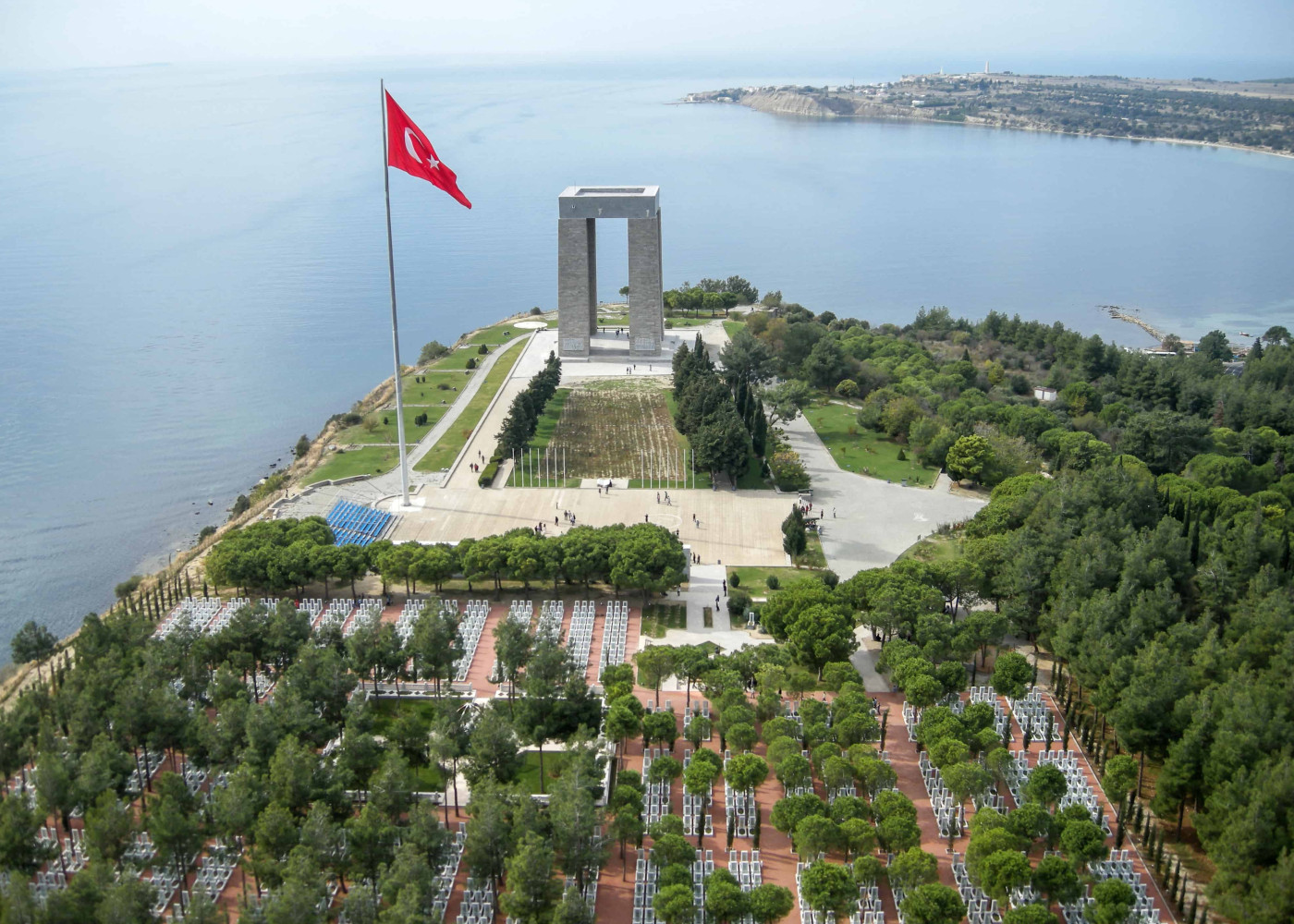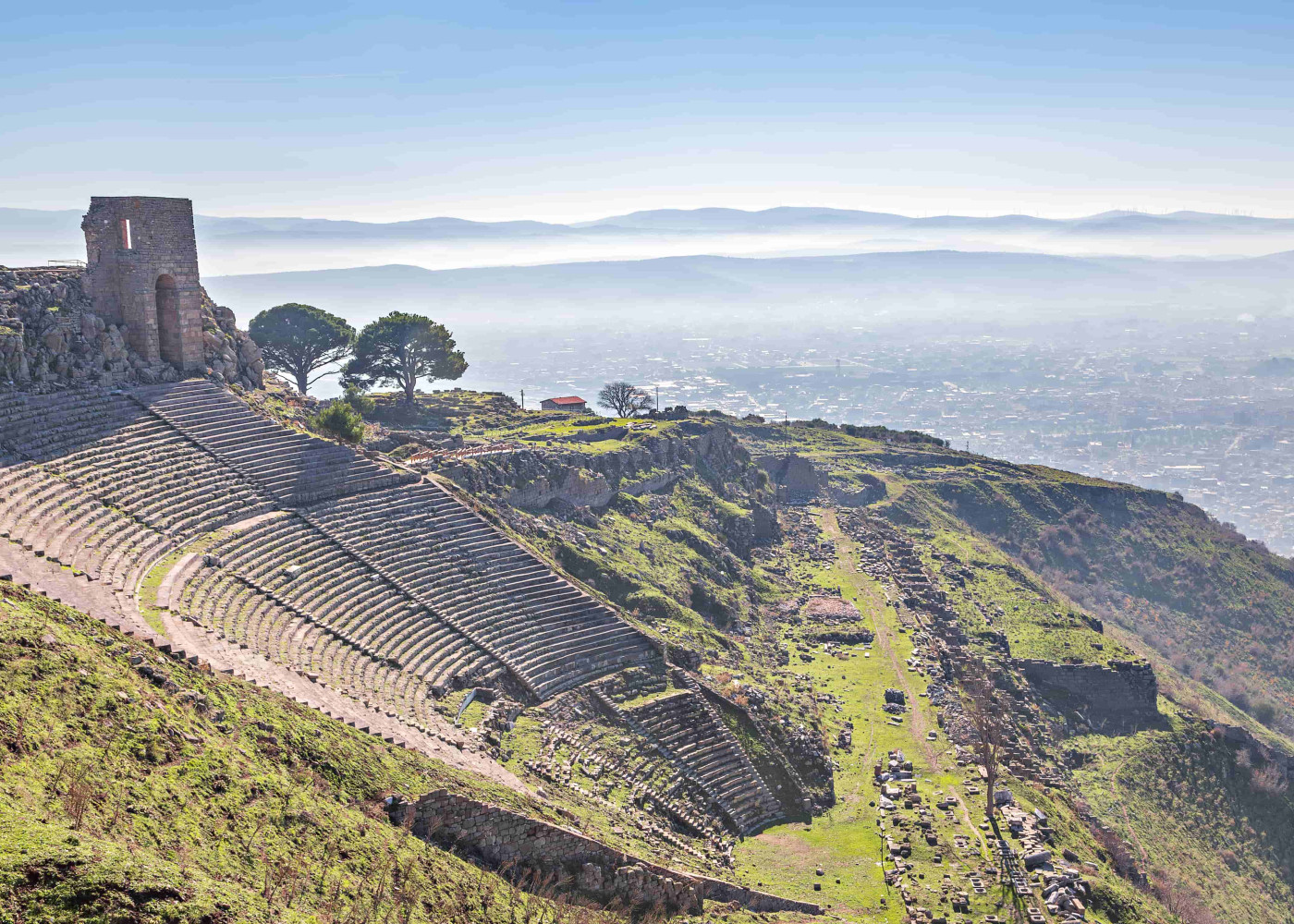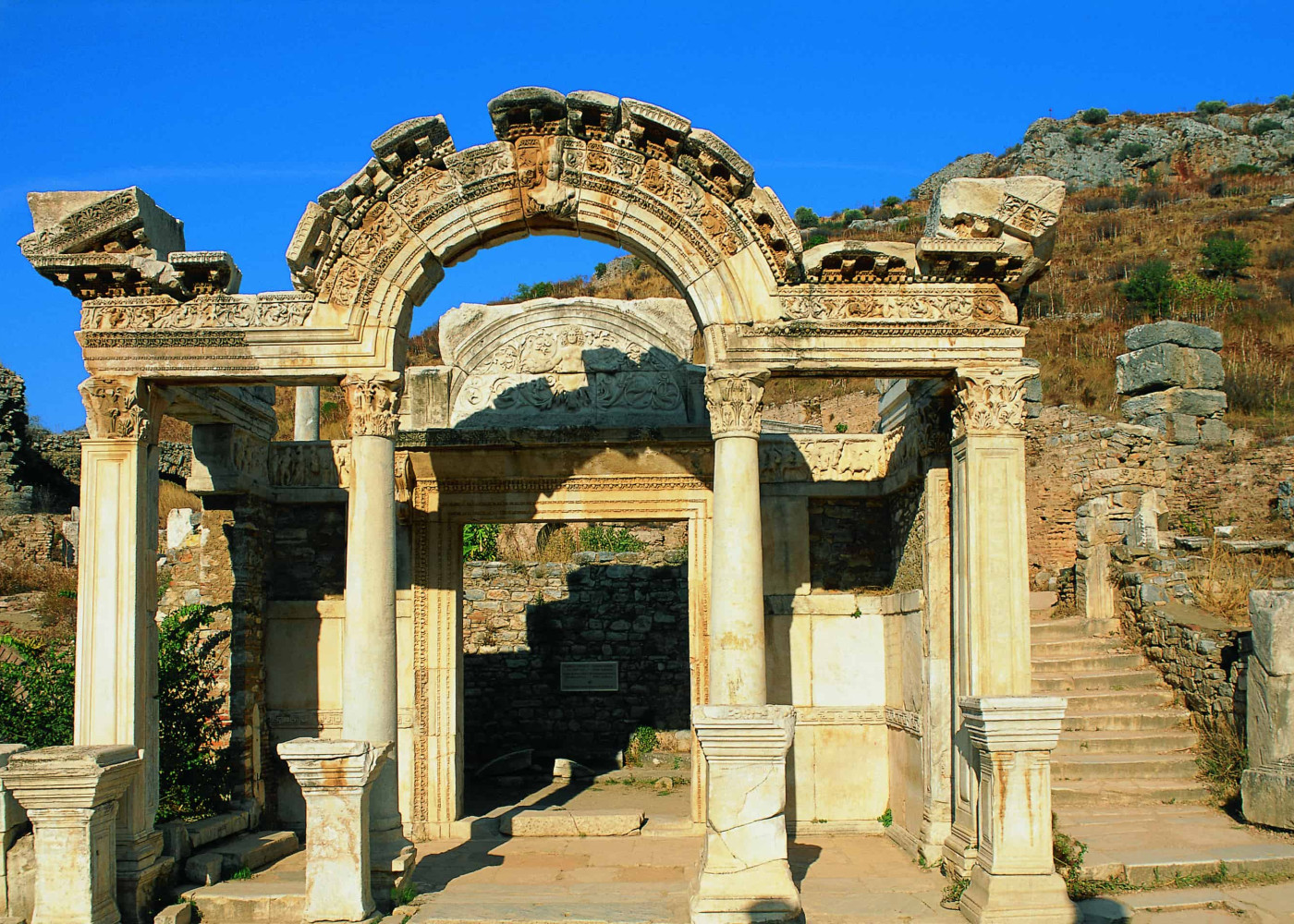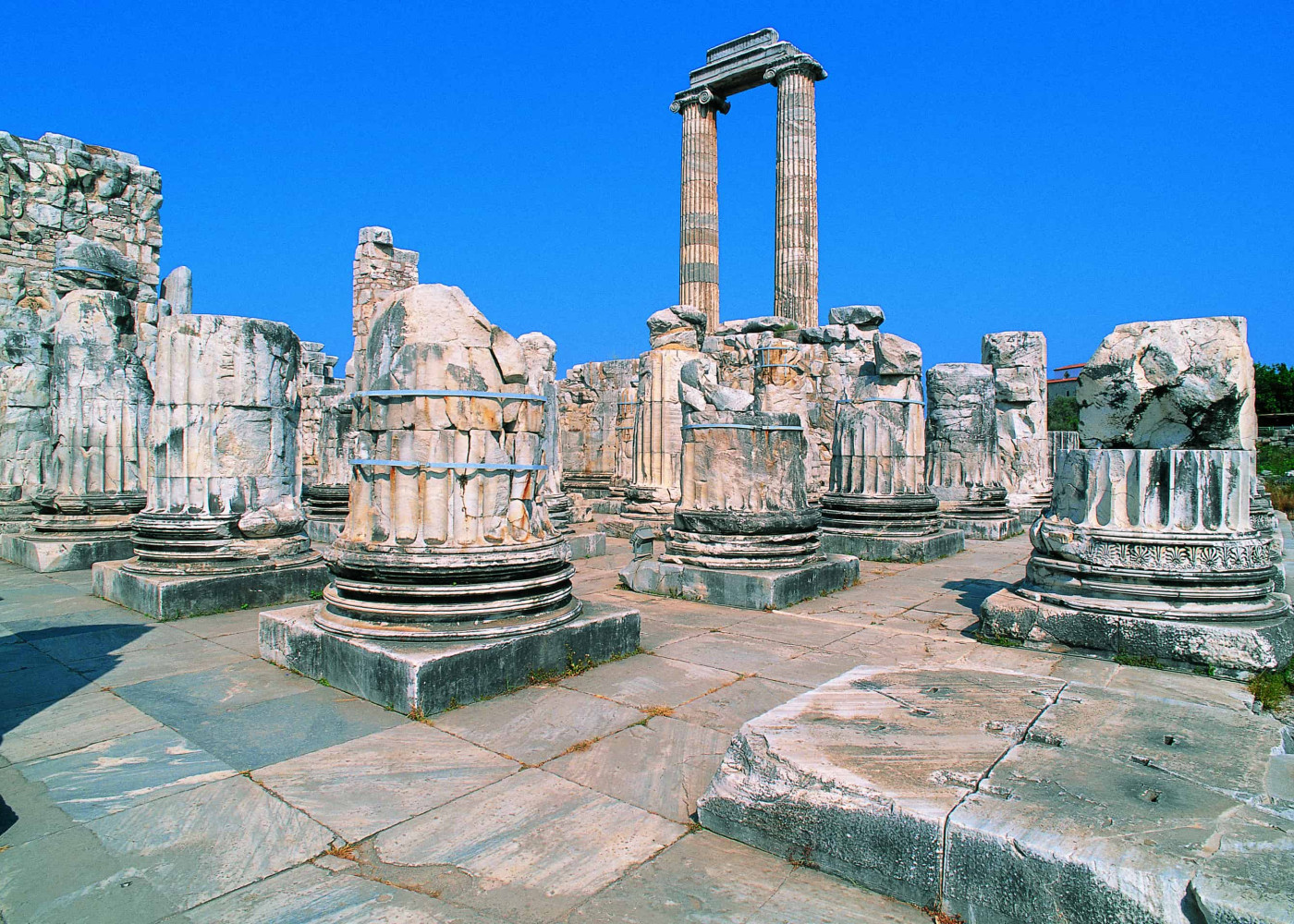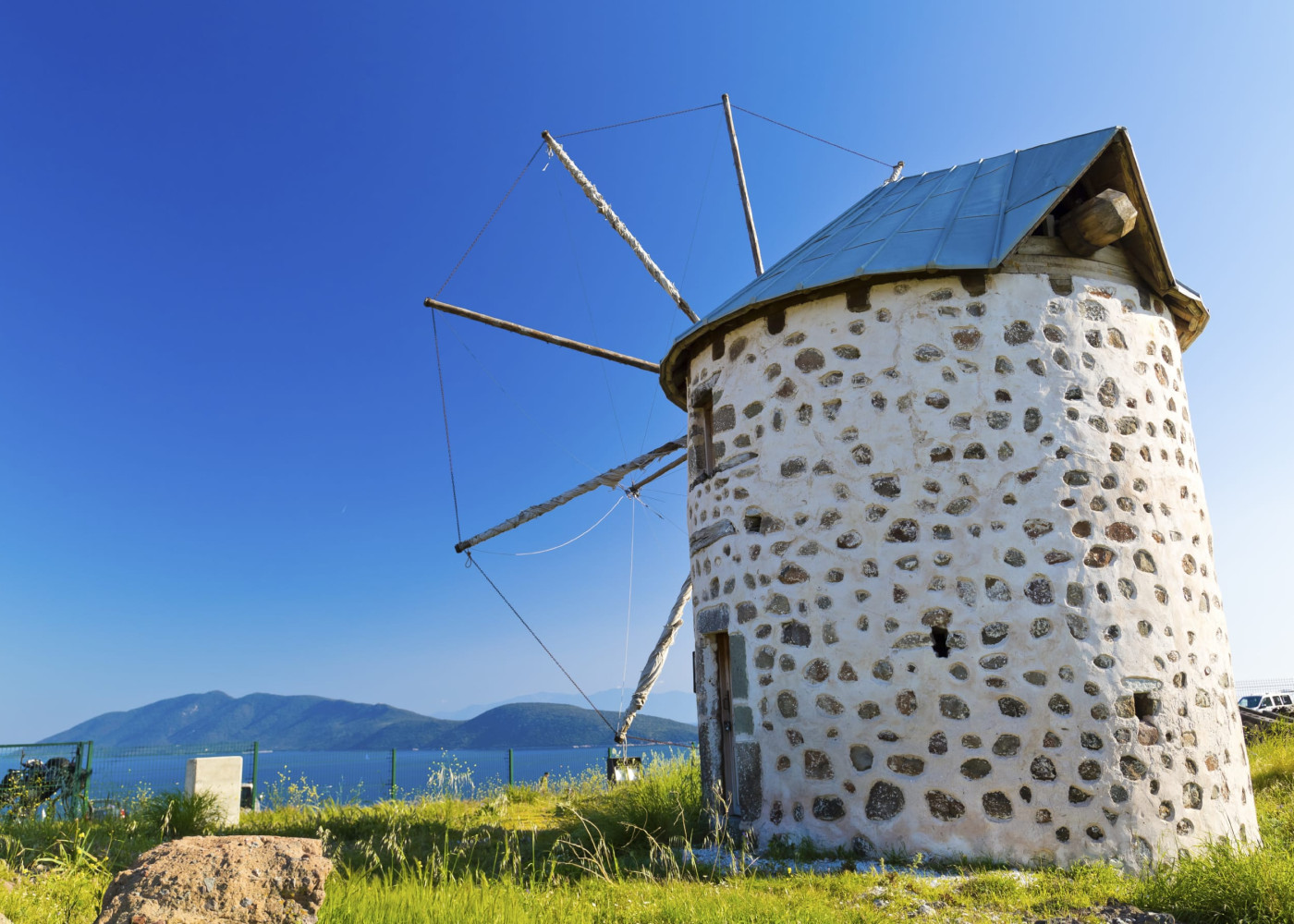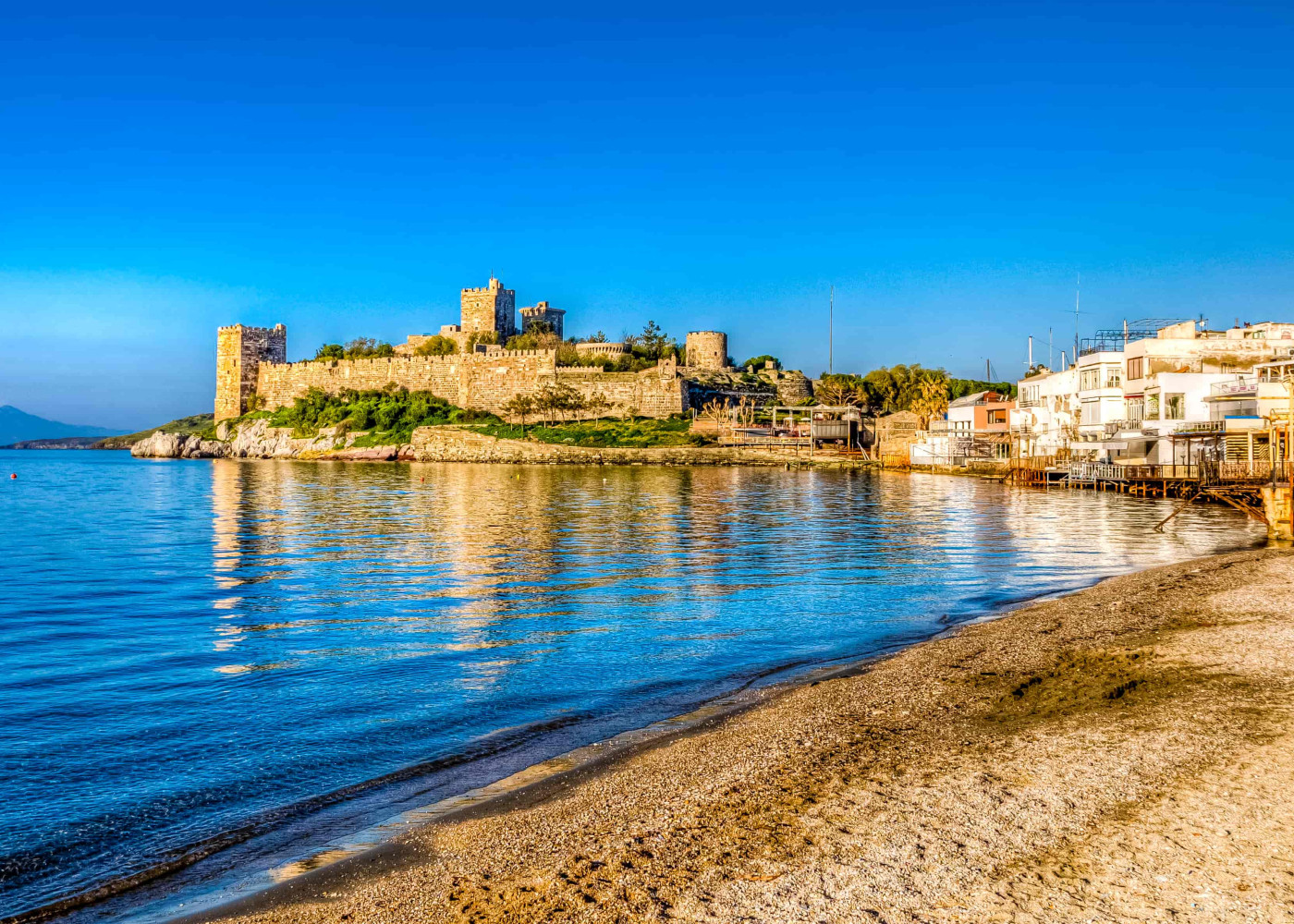Auto-tour en Turquie de Istanbul à Bodrum
Turquie, entdecken Sie diese 9-tägige Reise
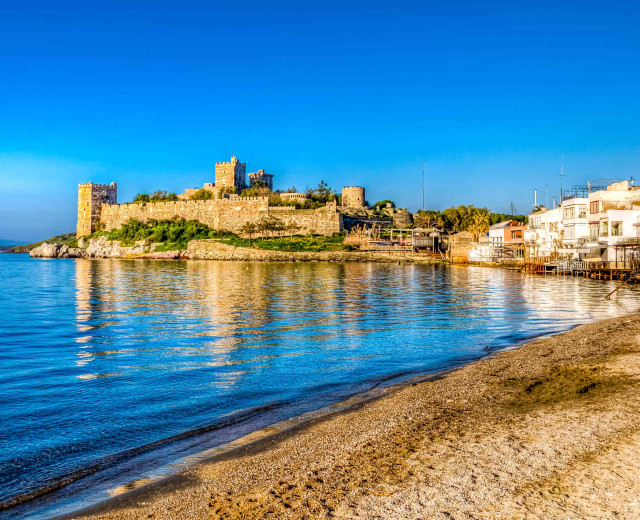
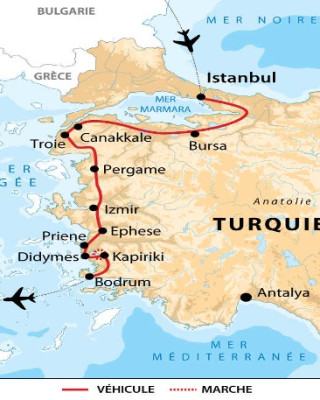
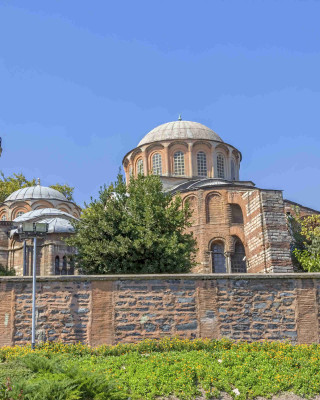
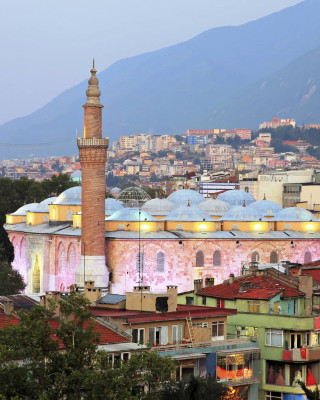
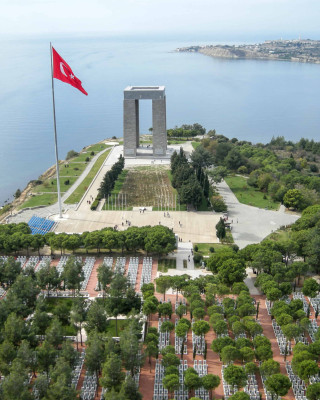
Beschreibung der Reise
Unterkunft
Reiseprogramm
Tag 1 :
Arrivée à IstanbulAccueil à l'arrivée à l'aéroport d'Istanbul. Transfert à l'hôtel et réunion d'info . http://www.hotelcentrumistanbul.com/
Tag 2 :
Istanbul (Petit déjeuner)C'est à pied, partis comme pour une randonnée à travers l'Histoire,que nous commençons notre visite depuis notre hôtel situé dans le centre historique. Nous faisons la visite conjointe de Byzance, de Constantinople et de la contemporaine İstanbul. Durant l'Empire Romain (de – 27 à 395), les plus importants évènements politiques de BYZANCE se déroulèrent sur la Place de l'Hippodrome (édifiée par Septime Sévère en l'an 203), parsemée de trophées de victoires. Fêtes et drames des ères romaine (jusqu'en 324) et byzantine (jusqu'en 1453) et même ottomane, s'y déroulèrent, au coeur même de la cité. Nous entrerons à deux pas de là dans la Mosquée Bleue (ou mosquée du sultan Hamet), entourée de ses 6 minarets, construite en 1615, pour célébrer la victoire des armées de l'islam sur les Byzantins. C'est un élève du grand architecte Sinan qui décida de son volume, de ses dômes étagés, de ses 20.000 carreaux de faience bleue, le tout dans des jardins de cyprès, d'oeillets et de tulipes. Une place à traverser et nous entrerons dans SAİNTE SOPHİE. Justinien, le successeur de l'empereur romain Constantin, décida de se faire construire en l'an 535 une église plus grande et plus somptueuse que le temple de Salomon à Jérusalem, et digne de la ''Nouvelle Rome''. İl fit démembrer les temples de Delphes, d'Athènes et d'Ephèse (dont l'Artémission, l'une des 7 merveilles du monde antique) et utilisa colonnes, plaques de marbre et autres matériaux précieux pour édifier sous une étonnante prouesse architecturale (l'immense coupole, restée longtemps inégalée) sa basilique, monument emblématique d'İstanbul. Un grand moment de notre visite... İstanbul étant bâtie sur 7 collines, nous descendons plein sud vers le bord de la Mer de Marmara. En traversant un quartier populaire et typique nous pouvons visiter la Petite Sainte-Sophie, également fondée sous Justinien.Ce grand bâtisseur de si nombreuses églises fut également l'ordonnateur sinistre du massacre de 30.000 de ses sujets sur la Place de l'Hippodrome, lors de la révolte de Nika, en 532. Un dîner stambouliote bien mérité, et une bonne nuit à l'hôtel. Après midi continuation de notre visite le PALAİS DE TOPKAPİ, l'ancienne résidence des sultans ottomans. Cet immense domaine est constitué de jardins,de bâtiments impressionnants édifiés au cours des siècles,de kiosques et de pavillons, de salles d'aparat aux riches décorations, de collections de trésors de toutes sortes (bijoux, vêtements, reliques, porcelaines,mobiliers,...), de fontaines et de statues, d'arbres séculaires et de pelouses fleuries: un immense et surprenant domaine situé au dessus de l'entrée du Bosphore. Le harem fera rêver certains, alors que d'autres blêmiront devant les joyaux entassés comme en vrac dans des salles à peine gardées. Certains apprécieront de saluer quelques poils de la barbe du Prophete Mahomet,ou son manteau qui voisine avec le bâton que Moise utilisa pour ouvrir la Mer Rouge, ou quelques ossements ayant appartenu à saint Jean-Baptiste. Vêtements brodés, soies et procelaines de Chine, salle du Divan d'où l'Empire ottoman était administré... Visite débordant de curiosités et de fortes images-souvenirs... De TOPKAPİ, descendre et longer le Bosphore vers le pont enjambant la Corne d'Or, pour parvenir au MARCHE EGYPTİEN ou MARCHE AUX EPİCES, en face de la Corne d'Or. Profusion de parfums et de couleurs. Nous pouvons alors remonter vers Ste Sophie et nous diriger à droite vers le Grand Bazar véritable caverne d'Ali Baba où chacun pourra dénicher le cadeau et le souvenir de ses rêves. Dîner dans un des nombreux restaurants avant l'Hippodrome. http://www.hotelcentrumistanbul.com/
Tag 3 :
Istanbul - Bursa (153 km)Le matin, mise à disposition de la voiture de location (classe économique). Traversée de la mer de Marmara en ferry et route vers Bursa, fondée au IIIe siècle avant notre ère par Prusias Ier, roi de Bithynie. Conquise en 1326 par le sultan Orhan Gazi qui en fit la première capitale de l’empire ottoman, Bursa fut embellie de monuments qui marquent l’émergence d’une nouvelle architecture turque fusionnant les influences persane, seldjoukide et byzantine, un patrimoine auquel s’ajoute le charme tranquille de la province et l’occasion de s’initier à l’art de vivre oriental. Promenade dans la ville haute, encore ceinte de sa muraille d’époques romaine et byzantine, pour la visite du complexe religieux Muradiye qui comprend une mosquée, une médersa et la première nécropole de la famille impériale ottomane, avec ses onze mausolées princiers. Puis, à flanc de colline, découverte de la mosquée Verte et le mausolée Vert dont les faïences sont signées par les maîtres de Tabriz. Enfin, flânerie dans le bazar et ses caravansérails.
Tag 4 :
Bursa - Canakkale (274 km)Petit déjeuner & Dîner Le matin, après la remise de la voiture, vous prendrez la route pour vous rendre à la Péninsule de Gallipoli. Visiter Eceabat, Alçıtepe et Seddülbahir est une expérience différente et qui ouvre les yeux pendant toute l'année, mais il y a une date spécifique où beaucoup d'Australiens ou de personnes ayant des ancêtres australiens viennent dans la région pour se souvenir de ceux qu'ils ont perdus, loin de chez eux. Chaque année, aux dates des 24 et 25 avril, des gens de Turquie, d'Australie, de Nouvelle-Zélande, du Royaume-Uni et de France organisent des services Anzac Day sur la péninsule de Gallipoli pour les soldats qu'ils ont perdus au cours de cette vicieuse bataille. Ces journées comprennent un service à l'aube pour le souvenir et une tournée de Gallipoli pour comprendre où et dans quelles conditions ces soldats ont combattu. Traversée en ferry pour la ville de Çanakkale. Arrivée et départ en bus pour notre hotel se trouve à Güzelyalı près de la mer. Dîner et nuit à l’hôtel. http://www.irisotel.com/
Tag 5 :
Canakkale - Troie - Pergame (245 km)Petit déjeuner & Dîner Le matin, vous pourrez visiter Troie,. Belle visite commentée de ce site exceptionnel. Nous y vivrons un grand moment au centre de cette semaine ''TROİE ET İSTANBUL''. HOMERE,(8me s. avant notre ère) raconte dans l'épopée de ''l'İLİADE la célèbre GUERRE DE TROİE (ville qu'il appelait ''İLİON'') qui aurait eu lieu vers 1250 avant notre ère. Les archéologues modernes, au 20 eme siècle, ont découvert au moins 9 époques successives en 5.000 ans d'occupation de ce site exceptionnel. Lors de notre visite guidée (nous saurons prendre notre temps) nous remontrons le temps et découvrirons sous nos pas les vestiges de ces différentes époques: allées pavées, théâtre, maisons, palais,temples... Avant de nous remémorer le récit de la GUERRE DE TROİE selon l'Histoire écrite par Homère, écoutons Ovide nous décrire la cause de cette guerre selon la mythologie grecque: Les 3 plus belles déesses grecques (Aphrodite, Athéna et Héra) (que les Romains identifieront avec leurs propres déesses: Vénus, Junon et Pallas) décident de concourir pour savoir qui, des 3, est en réalité la plus belle. Le concours se tiendra sur le Mont İDA (à 100 Km au sud-est de Troie), territoire appartenant à la Troade dont le roi est PRİAM. Et c'est PÂRİS, le fils de PRİAM, qui devra remettre le trophée à la lauréate divine. La très rusée déesse APHRODİTE passe un marché secret avec PÂRİS : S'il lui accorde le premier prix, elle lui promet l'amour de la plus belle des mortelles, une certaine HELENE, épouse du roi athénien MENELAS. PÂRİS est de suite convaincu et réussit, grâce à APHRODİTE à qui il a remis solennellement le premier prix de beauté sur le Mont İda, à trouver HELENE en Grèce, à l'enlever et à l'emmener chez son père le roi de TROİE où il se réfugie avec sa captive. Furieux, MENELAS demande à son allié AGAMEMNON, roi achéen de MYCENE, de l'aider à récupérer sa femme. AGAMEMNON navigue avec ses troupes vers TROİE et commence un siège qui durera 9 ans. Les Troyens recevront l'aide de Sarpédon, roi des LYCİENS, et d'ENEE, propre fils de la déesse APHRODİTE, mais seront finalement vaincus par AGAMEMNON. Celui-ci, connaissant l'amour des Troyens pour les chevaux, a fait construire un gigantesque cheval de bois, y a caché de solides héros armés dont Achile, Ajax,... et l'a offert à son ennemi Priam étonné et sans doute fatigué. Celui-ci fait élargir une des portes de la ville et laisse sottement entrer l'ennemi dans la place... Hélène, échappant ainsi à Pâris, peut alors revenir en Grèce. C'était il y à 3.250 ans... Après la visite vous prendrez la route pour Bergama. Visite de PERGAME, étonnante et superbe ville en 3 étages, concurrente d’Alexandrie à l’époque grecque et romaine. Dîner et nuit à Pergame. 2h de randonnée urbaine. http://hotelhera.com
Tag 6 :
Bergama - Selçuk (Ephèse) - 3 heures de routePetit déjeuner & Dîner Traversée d’IZMIR (brûlée en 1922) et vous arrivée à EPHESE. Ephèse est la cité gréco-romaine antique (plus de 2.000 ans) la mieux préservée de la Méditerrannée orientele; c’est là sans doute que l’on saisit le mieux ce qu’était une ville romaine. La capitale de la Province Romaine d'Asie comptait près de 250. 000 habitants et se vantait d’être la «première et plus grande métropole d’Asie» . Elle fut choyée et embellie par les empereurs successifs qui y laissérent des monuments que notre visite nous permettra d'apprécier. C'est a SELCUK, a l'emplacement de l'EPHESE primitive (avant l'envasement de la baie et le déplacement de la capitale plus prés de la mer) que se dressait ''L'Artémission'', le temple dédié a Artémis, classé parmi les 7 merveilles du Monde antique, et détruit par l'empereur Justinien au 5 éme siécle pour construire avec ses colonnes la basilique Ste Sophie d'İstanbul. L'envasement du port ayant condamné une nouvelle fois tout commerce, EPHESE fut finalement abandonnée au 4éme siécle au profit de BYZANCE. Dîner et nuit à Selçuk/Ephèse.2h30 de visite (marche !) commentée. http://www.kalehan.com/
Tag 7 :
Priene - Milet - didymes - Lac de BafaPetit déjeuner & Dîner Le matin, vous prendrez la route en direction de Priene et MIlet. Visite des villes grecques et romaines de PRIENE, MILET et du temple d’Apollon à DIDYMES.Après la visite, vous avez 1 heure de trajet vers le Sud, vous parvenez au bord du lac BAFA, lui-même formé par l'envasement de l'ancienne baie dans laquelle débouche le Fleuve Le Méandre. Ce lac est dominé par le Mont LATMOS (1375 m) dont la forme tourmentée lui a fait gagner le surnom par les Turcs de ''Montagne des 5 doigts''. İl y a 2200 ans (à la période romaine), la rivière ''Méandre'' n'avait pas encore fermé de ses alluvions cette profonde baie qui continue a se combler peu à peu. Elle a été coupée de la Mer Egée, et est devenue ce magnifique lac aux eaux saumâtres.L'ensemble (montagne et lac) est devenu derniérement un Parc Naturel rigoureusement protégé. De nombreuses espèces d'oiseaux, dont certaines très rares, s'y trouvent désormais en sécurité: pélicans, flamands roses, grues, cormorans, canards, cigognes et autres migrateurs. Dans le lac se pêchent encore des anguilles, mulets et brochets. La nature environnante est sauvage, présentant de grandioses chaos de roches ocres. Des hommes se sont installés très tôt dans les grottes du Mont LATMOS et y ont laissé des traces et des peintures que les archéologues datent d'il y a 11.000 ans (peintures rupestres que nous irons voir). Puis,il y a 3.000 ans, ce sont les Cariens qui découvrirent à leur tour cet endroit retiré et y construisirent leurs villages. Sous le roi MAUSOLE, ils créèrent le port d'HERACLEE qui prit une grande importance commerciale jusqu'à ce que l'envasement le coupe de la mer et interdise aux navires d'y accoster. Au 7ème siècle de notre ère, une importante colonie de moines (300) chassés du Sinai par les Arabes colonisant l'Egypte et la Palestine, s'arrêta ici dans sa fuite. Le site est grandiose, sauvage et très beau, et leur offrait un abri sûr dans les grottes de cette montagne tourmentée dominant le lac. İls y ont construit de nombreux monastères fortifiés et laissé de nombreuses peintures byzantines dans les grottes et les couvents fortifiés que nous visiterons. C'est au printemps que la nature est la plus belle ici, mais hors l'été (grosse chaleur) le séjour au bord du Lac BAFA est agréable pratiquement toute l'année grâce à la clémence de la température à cette latitude et a proximité de la Mer Egée. Arrivéz au village de Kapıkırı. Vous prenez possession de vos chambres au bord du lac, dans le village de KAPIKIRI, où la vie rurale nous enchantera: nombreux ânes, vaches et oies, etc. Cuisine locale à l'huile d'olive et aux herbes de la montagne; poissons du lac, légumes du jardin, lait cru du village, miel ... Dîner au bord du lac et nuit calme. http://selenespansion.com/
Tag 8 :
Visite de l'ancien Heraclée et randonnée sur le Mont Latmos ( Randonnée de 4 heures)Petit déjeuner, Pique-Nique & Dîner Départ de la randonnée avec un guide local depuis votre hôtel. Le village de KAPİRİKİ a remplacé l'antique HERACLEE, et il subsiste partout des vestiges vieux de 2.400 ans: les remparts (au nord du village) qui font prés de 7 Kms de long et qui étaient gardés par 65 tours ou donjons dont certains subsistent encore. Sur l'AGORA d'HéRACLéE a été construite sans plus d'états d'âme l'actuelle école du village, mais un plan de la cité antique nous aide a comprendre sa configuration. En descendant vers la rive du lac, on parvient au TEMPLE D'ATHENA (3éme siécle avant notre ére) dressé sur un petit promontoire. Et au bord du lac, de nombreuses tombes cariennes creusées dans les rochers énormes ne sont qu'une partie de l'immense NECROPOLE du LATMOS (plus de 2.500 tombes ont été recensées par les archéologues!). Remontant du bord du lac, nous faisons une boucle sur les flancs du Mont LATMOS (rando de 2 h) pour admirer le paysage fantastique et découvrir d'autres témoignages de ce passé mouvementé.. 4 heures de marche. Dîner au bord du lac et nuit calme. http://selenespansion.com/
Tag 9 :
Bodrum - RetourPetit déjeuner Et voilà apres un étape formidable, restitution de votre véhicule à l´aéroport de BODRUM et retour a votre pays avec de bon souvenir. Petit déjeuner * Cet itinéraire d'une semaine est spécialement étudié pour une découverte approfondie de l'Istanbul et la Côte Egéenne.
- Dauer : 9 Tage
- Preis : Ab 950,00 € pro Person
- Reiseziele: Turquie
Eine Website von
Passen Sie Ihre Reisen mit Quotatrip an und erhalten Sie maßgeschneiderte Angebote direkt in Ihr Postfach.
Ein Land entdecken
